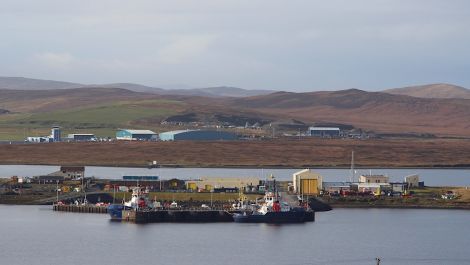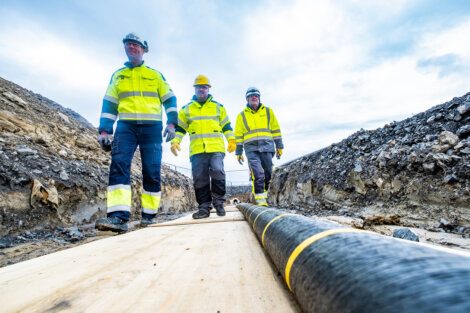Energy / Offshore wind leases ‘huge boost’ to plans for large-scale hydrogen production
The ORION project is continuing at pace – and offshore wind is a key element in its vision for a ‘clean energy island’
HYDROGEN production could take place in Shetland on a “serious scale” in the years ahead – but offshore wind development is needed for this to come to fruition.
Coordinator of the ORION clean energy project Gunther Newcombe said production of hydrogen and hydrogen derivative fuel for export could essentially replace oil and gas activity over time.
The production of green hydrogen is a key component of the ambitious ORION project, and it could be produced as a by-product of offshore – and onshore – wind.
Newcombe said this was a “huge boost” to the ORION project – a multi-partner initiative to transform Shetland into a “world-leading clean energy island” – and was testimony to the initiative already proving a success.
“ORION has three overarching ambitions – one is to create green hydrogen at scale for export, and the second one is to provide affordable energy for Shetland community and businesses, and the third is to help the oil and gas sector to decarbonise,” he said.
“For all of those things you need offshore wind – there’s not enough onshore wind available.”
He said there could end up being about 400,000 tonnes of hydrogen produced every year in Shetland, which could be exported as far as Europe.
In what is an emerging industry, hydrogen could be used as an alternative to burning fossil fuels to decarbonise many parts of the economy, including industries, transport, power and heating.
Become a supporter of Shetland News
Newcombe said the primary business driver behind the three offshore wind sites is to “create electricity from wind and transport that to shore, and then create hydrogen, then create hydrogen derivative fuels”.
Sullom Voe – both the terminal and the port – have been earmarked as a potential base for hydrogen activity, and although oil and gas production is expected to continue for decades during the energy transition.
Shetland Islands Council is currently inviting expressions of interest in developing the land around the port of Sullom Voe.
“The site at Sullom Voe, it is an industrial site, so that’s where it should go,” Newcombe – a former Sullom Voe Terminal manger – said.
“So, reutilising equipment and repurposing the terminal is one aspect. We have Scatsta there as well, we have Sella Ness, we have the port facilities, and there’s the other ports in Shetland in Lerwick and Dales Voe.
“We’re looking at this in a fairly broad way. The ports will play an important part in supporting the offshore wind sector, for the assembly of wind turbines for instance, and we’ll need some invest to actually enable them to do so.
“The port of Sullom Voe would be the location where you export clean fuels – you have four jetties there, you have the marine structure.”
Newcombe added that the potential hydrogen production is on the radar of the Scottish Government, which itself has created a hydrogen action plan.
Another part of the rather complex future energy jigsaw is the onshore wind which will be generated in Shetland in the years ahead.
Newcombe said talks are continuing with ORION – which aims to sustain existing roles and create potentially 500 jobs by 2030 – and the onshore wind developers.
The 600MW subsea interconnector is set to link Shetland to the national grid in 2024 and allow the 443MW Viking Energy wind farm to export power.
But Newcombe said there is potential for 750MW of energy to be generated in Shetland once other wind farms are built, alongside Nova Innovation’s tidal turbines.
“We’re working very closely with all the onshore wind and tidal developers in Shetland to sort of see if there are other uses of that [surplus] electricity – could we be creating green hydrogen as an example on the island, for the island, from onshore wind and tidal resource – at an affordable price.”
There also stands to be announcements next year around Crown Estate Scotland’s INTOG leasing round – a scheme to support the decarbonisation of oil and gas installations through offshore wind.
But it is, of course, a long game – the first offshore developments in the waters around Shetland may only go live in 2028 at the earliest.
Community benefit from offshore wind could come through electricity, potentially offering cheaper energy for Shetlanders, or other forms such as money, training or infrastructure.
But with the future energy projects years away yet, that will not help those struggling to pay the bills this winter.
Meanwhile Newcombe stressed that engagement continues with the fishing industry – a sector which has expressed great worry at offshore wind development.
“I think what’s really important here, what we’re trying to do in Orion and also with the SIC, is to make sure that other really important industries on Shetland, like fishing for instance, aquaculture, crofting – core industries – are also not affected by offshore wind, or any effect is minimised,”
“We’re in pretty continuous dialogue with SFA [Shetland Fishermen’s Association] and other key stakeholders like them.”
ORION is described as a strategic framework where its partners and interested parties work together on the renewable energy future in the drive to net zero.
It involves Shetland Islands Council, Highlands and Islands Enterprise, the Net Zero Technology Centre and the University of Strathclyde.
Become a supporter of Shetland News
Shetland News is asking its many readers to consider start paying for their dose of the latest local news delivered straight to their PC, tablet or mobile phone.
Journalism comes at a price and because that price is not being paid in today’s rapidly changing media world, most publishers - national and local - struggle financially despite very healthy audience figures.
Most online publishers have started charging for access to their websites, others have chosen a different route. Shetland News currently has over 600 supporters who are all making small voluntary financial contributions. All funds go towards covering our cost and improving the service further.
Your contribution will ensure Shetland News can: -
- Bring you the headlines as they happen;
- Stay editorially independent;
- Give a voice to the community;
- Grow site traffic further;
- Research and publish more in-depth news, including more Shetland Lives features.
If you appreciate what we do and feel strongly about impartial local journalism, then please become a supporter of Shetland News by either making a single payment or monthly subscription.
Support us from as little as £3 per month – it only takes a minute to sign up. Thank you.



























